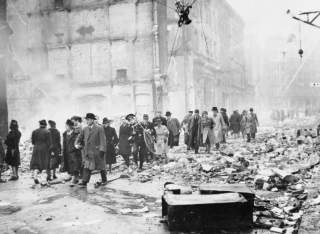This Is How Britain Took Advantage Of The Horror Of World War II
It had a great opportunity to rebuild itself.
It is 75 years since the bombs of the Blitz reduced buildings to rubble in cities across the UK. It is estimated that the operations of the German air force left as many as 43,000 civilians dead and 46,000 injured. Yet from the horrors of the Blitz emerged an opportunity to rebuild.
In London in particular, the effort to rebuild was characterised by an implicit focus on addressing inequalities of the period, with a strong emphasis on public health. Attention was paid to ensuring the provision of proper housing, sanitation, recreational spaces, free education, the formation of the National Health Service (NHS) and so on. Concerns about the impacts of mass unemployment and poverty also factored into this approach to post-conflict rebuilding.
A history of inequalities
These considerations were partly due to the problems that plagued the poorer parts of London in the pre-war period. When medical officers were recruiting in London’s East End during World War I, it was discovered that over 37% of the population had a physical impairment or condition which meant that their health was compromised.
The Spanish influenza pandemic of 1918 to 1919 – which killed millions of people globally – affected almost every household in the East End. And during World War II, the East End continued to be marred by poverty, overcrowded slums, criminality, dangerous and difficult working conditions, and a lack of sanitation and access to medical care. All of these factors were known to lead to impairment and ill health.
Addressing these social and physical ills was a priority, alongside the rebuilding of historically important buildings and preservation of cultural artefacts. Yet despite these good intentions, many crucial steps were missed. For example, the existing disabled population and those who were left impaired during the war were neglected, throughout what was essentially a top-down planning process.
A missed opportunity
World War II was infamously characterised by the ideology of Nazism, which propagated inequality and the exclusion of certain groups from society. Yet when the opportunity came to rebuild truly equal cities in Britain, it was largely lost. Of course, remedies were sought to help heal the trauma of conflict. Oral and visual histories of those injured, disabled and killed were memorialised in museums and monuments such as the tombs of unknown soldiers. Victims were supported with medical and rehabilitative services, for example in Stoke Mandeville Hospital, which is commonly credited as the birthplace of the Paralympic Games.
Former servicemen also campaigned for greater inclusion in society. These campaigns have led us to think again about memorialisation: disabled people are now actively included in truth commissions, peace movements and the rethinking of cultural spaces, such as in Colombia’s National Museum of Memory.
Although such measures are important and necessary in any post-conflict setting, they still frame the needs of disabled people as specialised issues within health systems, charitable aid or institutional contexts. We rarely consider them in our broader plans for rebuilding the structures, cultures, environments or even the economies of post-war societies, and we don’t consider how we can prevent disability in the way we reconstruct our cities.
It is possible to promote equality and peace in the cultures that arise in our cities after conflict – whether it’s through material designs, or national and international relations. Nagasaki in Japan is one example of a place where a culture of peace is promoted through education, ceremonies and the design of public spaces.
By excluding certain sections of society from discussions about rebuilding post-World War II, we consequently prevented their participation in public spaces. If an injured person does not have a say in how their city is rebuilt, they cannot tell planners about the features they need to access and enjoy a park, see a doctor, or travel using public transport. By discounting these voices, you recreate exclusionary citizenship, violate their rights and disable them. As a result of these oversights in the post-war period, large swathes of the London Underground are inaccessible to wheelchair users.
Yet there’s hope for the future; cities can engage with the perspectives of disabled people, and this can pay huge dividends when it comes to addressing inequalities and creating truly sustainable and democratic societies. In Brussels, a more accessible underground was created with the expertise and partnership of disabled people. And so we see that it is possible to ensure that disability “counts” when it comes to public spaces and cultural heritage.
Maria Berghs, Research Fellow, University of York
This article is republished from The Conversation under a Creative Commons license. Read the original article.
Image: Wikipedia.

